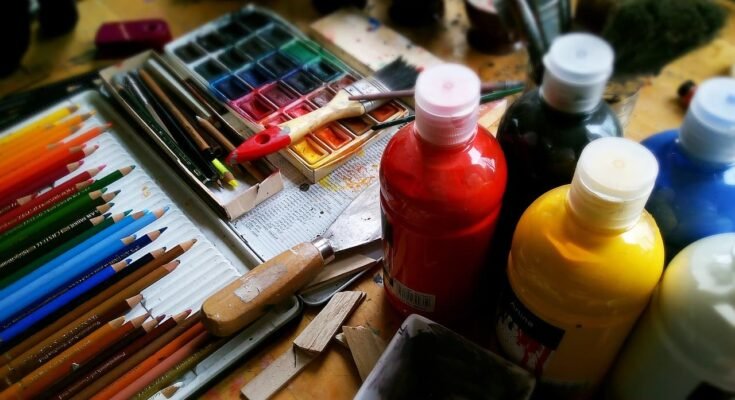Introduction
Color mixing is an essential skill for any artist, whether you’re a beginner or a professional. Knowing how to blend different colors effectively can enhance your artistic expression.
In this comprehensive guide, we’ll cover everything you need to know about creating a perfect paint palette and mixing colors like a pro. Paint Palette.
Table of Contents
- Understanding the Basics of Color Theory
- Types of Paint Palettes
- Essential Tools for Color Mixing
- Step-by-Step Guide: How to Mix Colors Like a Pro
- Color Mixing Techniques
- Common Mistakes in Color Mixing and How to Avoid Them
- Top Tips for Achieving Perfect Color Blends
- Frequently Asked Questions (FAQs)
- Conclusion
Understanding the Basics of Color Theory
Before mixing colors, it’s important to understand the basics of color theory. Color theory provides a foundation for creating harmonious color combinations. Paint Palette.
What is Color Theory?
Color theory involves the visual effects of colors and their combinations. It explains how colors interact and influence each other.
The Color Wheel
A circular diagram known as a color wheel represents the relationships between primary, secondary, and tertiary colors.
- Primary Colors: Red, blue, and yellow.
- Secondary Colors: Green, orange, and purple (formed by mixing primary colors).
- Tertiary Colors: Created by mixing primary and secondary colors.
Warm and Cool Colors
- Warm Colors: Red, orange, and yellow (associated with warmth and energy).
- Cool Colors: Blue, green, and purple (associated with calmness and serenity).
Types of Paint Palettes
The choice of palette can affect how colors are mixed and applied. Paint Palette.
Traditional Wooden Palette
- Pros: Lightweight and easy to handle.
- Cons: It absorbs some paint and requires frequent cleaning.
Glass Palette
- Pros: Easy to clean and durable.
- Cons: Heavier and more prone to breakage.
Disposable Paper Palette
- Pros: Easy cleanup, ideal for oil paints.
- Cons: Not eco-friendly and may be less durable.
Stay-Wet Palette
- Pros: Keeps acrylic paints moist.
- Cons: Needs maintenance to prevent mold.
Essential Tools for Color Mixing
To mix colors like a pro, you’ll need the right tools:
- Paintbrushes: Various sizes and types for adequate mixing.
- Palette Knife: Useful for blending thicker paints.
- Water or Medium: Helps to achieve the right consistency.
- Palette Paper or Surface: A clean area for mixing.
Step-by-Step Guide: How to Mix Colors Like a Pro
Step 1: Prepare Your Palette
- Set up your palette with primary colors (red, blue, and yellow).
- Include black and white for shading and tinting.
Step 2: Start with Primary Colors
- Mix primary colors in equal proportions to get secondary colors.
Step 3: Create Tertiary Colors
- Blend primary and secondary colors for more complex hues.
Step 4: Adjust Saturation
- Add black or white to adjust the saturation of the color.
Step 5: Test the Colors
- Test the mixed color on a separate sheet before applying it to the artwork.
- Color Mixing Techniques
- Direct Mixing
Mix two colors directly on the palette to create a new hue. Paint Palette.
Glazing
Apply a thin, transparent layer of color over another to create depth.
Dry Brushing
Use a small amount of paint on a dry brush to blend colors directly on the canvas.
Scumbling
Apply a broken layer of color over another for a textured effect.
Common Mistakes in Color Mixing and How to Avoid Them
Mistake 1: Overmixing
- Solution: Stop mixing as soon as you achieve the desired shade.
Mistake 2: Using Too Much Black
- Solution: Use complementary colors for darkening instead of black.
Mistake 3: Ignoring Warm and Cool Tones
- Solution: Be aware of warm and cool undertones while mixing.
Top Tips for Achieving Perfect Color Blends
- Use a Clean Palette: Always start with a clean palette to avoid unwanted color contamination.
- Understand Color Ratios: Practice blending different ratios of primary colors.
- Experiment with Mediums: Try using water, oil, or other mediums to achieve consistency.
- Create a Color Swatch Sheet: Record successful blends for future reference.
Frequently Asked Questions (FAQs)
Q1: What is the best way to mix colors for skin tones?
A: Mix equal parts of red, yellow, and blue, then add white to adjust the lightness—Fine-tune with red or yellow for warm undertones and blue for cooler ones.
Q2: How do I make colors look more vibrant?
A: Use pure primary colors and avoid mixing complementary colors excessively, as they can dull the vibrancy. Paint Palette.
Q3: Why does my color turn muddy?
A: Overmixing and using too many colors at once can result in a muddy appearance.
Q4: What is the best palette for beginners?
A: A stay-wet palette is ideal for beginners, especially for acrylic painting, as it keeps paints moist for longer.
Conclusion
Mastering the art of color mixing requires practice, patience, and understanding of color theory. You can mix colors like a pro by experimenting with different tools, techniques, and palettes, creating beautiful and harmonious artwork. Paint Palette.



